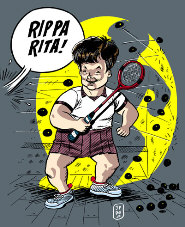About a Reverse Boast
Published: 20 May 2005 - 06:57 by rippa rit
Updated: 23 Oct 2012 - 21:07
Subscribers: Log in to subscribe to this post.

- Off a loose serve
- It is effective off a loose serve, because the Server is often "ducking" or too scared to move into the T (centre of the court).
- As a surprise, when the opponent is expecting length
- It is better to make it a hard shot, that is not too high above the tin, and does not travel too far along the front wall.
- The preparation for the shot to look like a drive or drop shot.
- Use your body (by turning), which can then often cause the opponent to move, and have to run right around your body to get to the ball.
What is a "give away" when playing a reverse boast?
- Standing "front on" (facing the front wall), limiting the possible returns. Also making it hard to know your opponent's court positioning.
- Short backswing (shows the opponent the ball is going to be struck well in front of the body) which would indicate a cross court drive or reverse boast.
- Playing the shot too often (opponent reads it or takes a guess), especially if your game lacks a drop shot.
Replies...
Please Note: The most recent replies are now at the top!
From benson - 23 Oct 2012 - 21:05 - Updated: 23 Oct 2012 - 21:07
From mrbrown - 30 Jan 2010 - 09:42 - Updated: 30 Jan 2010 - 09:43
I dont like the idea of boasting, I find its a cheap shop. But I do use it a couple times a game randomly to throw my opponent off 
From adam_pberes - 14 Feb 2009 - 11:48
Dont forget about reverse boasts from the back of the court, from a drive that has been overhit!
I find that usually comes off good when the opponent isn't watching and theyve drifted too far back.
Only thing is you have to make sure they have drifted back, otherwise you risk hitting them if theyre right on the T. (in which case, you shouldnt be trying that anyway :P)
From rippa rit - 13 Feb 2009 - 14:52
aprice - with the reverse boast, of course it depends where it is hit from, eg front court, return of serve, mid court. The striker is entitled to all the requirements of Rule 12 - Interference, and have freedom to hit the ball no matter where it is. Once having struck the ball the incoming striker must also then have free access to the ball. The fact that it is a reverse boast does not mean the player does not have to clear the ball. What the incoming striker does have to show is that they could have got to the ball. Reverse boasts are best hit from about mid court (when the opponent is held behind and there is plenty of room for the player to get to the ball) or on the return of serve (when the server is held from returning to the T, normally because of their lose serve).
If any boast for that matter is not low and tight as the ball comes off the front wall, it is pretty useless.
From aprice1985 - 13 Feb 2009 - 00:19
I was interested to see that you always put the onus on the reciever of the reverse boast to make every effort to get to the ball, in my experience a lot of reverse boasts played in the front court cross over in front of the player who hit the shot, i.e. if they stand on the T the ball will end up bouncing off the front wall and onto the floor in front of the T. To me they have in essence hit the ball back into themselves just by a more circuitous route so surely they must make every effort to get out of the way of the ball. This may not be such a problem in more advanced players who keep the reverse boast tighter to the side wall but frequently i feel i could take two steps forward from the T to hit a reverse boast but my opponent is stood on the T in my way.
From yelattal - 11 Feb 2009 - 22:09
Sorry, only members can post replies on this and all other Members` Forum items.
Support Squashgame
Support us here at Squashgame.info! If you think we helped you, please consider our Squash Shop when purchasing or make a small contribution.

Your opponent never has to "run right around your body to get to the ball" unless he has deliberately positioned himself so that you are in the way of a direct path to the ball. If he honestly misjudges the ball and moves so that you are now interfering, he is still even at that point entitled to a direct path to the ball. This is not a case of "created interference" in the sense of 12.7.4.
Back to top